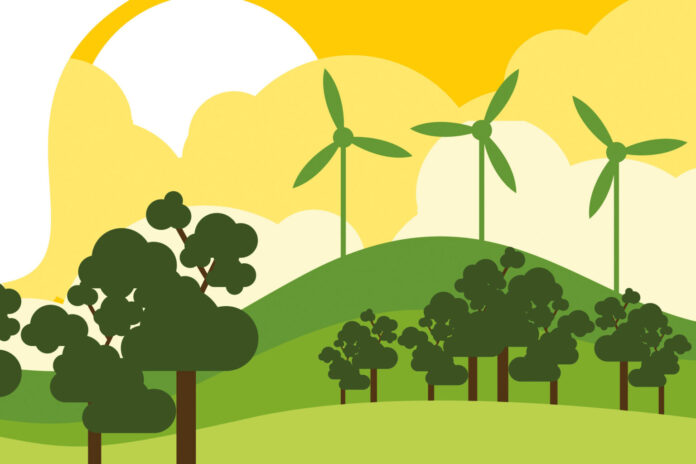
By Alissa MacMillan
Q: I sometimes give cut flowers as a gift and am not sure whether doing that is helpful or harmful for the environment. Any insights on this?
A: You’ve asked a great question because flowers are so beneficial for the earth and, at the same time, those sold in shops might come wrapped in plastic and be shipped from far far away. According to Britta Baranowsky, a flower-grower based in Wicklow and former chairperson and current committee member of Flower Farmers of Ireland, we have reason to be wary.
“The flower industry is very unsustainable on so many levels,” she explains. “The growing conditions in Africa and South America, the use of water, the use of chemicals, the labour is not paid well, of course you have the transport, all of the cooling, all of that energy consumption.”
“And then you also have a massive wastage, with whatever doesn’t sell just going to waste,” she adds. “It’s a very big business with lots of waste and lots of milage.”
That doesn’t mean there aren’t ways to do it right. For a start, think locally, seasonally, and creatively. Baranowsky started growing flowers outdoors in 2010, always with the environment in mind.
“My attitude was, I’m not going to fight the climate, I’m going to grow whatever grows well here in the Irish climate.” It turns out, that’s quite a bit. Growing outdoors, growth is slower but the flowers are tougher, so the vase life is longer, she says.
“These days I also grow something in the tunnel just to extend my season,” and it gives her control of her crop. Growing with organic principles, she is still mindful of how much heat and water her flowers need.
LOCAL & SEASONAL IS BEST
Ireland is a great place to grow flowers, water not being nearly as much of a problem as in other countries. You need a little bit of heat here, especially in the winter, as “the daylight hours are just not enough here.” Unlike other countries, Ireland doesn’t have a weekly-flower-bouquet purchasing kind of culture, says Baranowsky, more for special events like communions, weddings or as a gift.
For the times you do buy flowers, just like with produce, local and seasonal is always best. Not that it’s all that easy to know what’s in season. “People have no idea when a flower would be in season or not,” she explains, “because they are always available in the shops, like with vegetables these days, but even more so with flowers.”
Baranowsky suggests thinking differently about arrangements and being open to what each month brings. “No week is ever exactly the same in terms of availability,” with big changes happening every three to four weeks. As she notes, turning to new flowers every few weeks is its own way of enjoying the change of seasons, like dahlias, calla lilies and roses in summer, hydrangea, elderberry and helenium come autumn.
POLLINATION
As for her garden, Baranowsky has lots of bees and insects, evidence that it’s great for pollinators. Because she tries to have as long a season as possible for cutting, she also supports insects for longer. She cuts before a pollinator arrives, so before they open up or seed, but she feels like there is plenty to go around – “You never cut every flower anyway.” Even the smallest of flower gardens provide islands of food for insects, something she wishes existed more in hedgerows. And in case you’re worried, she’s never been stung by a bee. “It’s a happy environment,” she says.
The best first step for getting flowers sustainably is to grow a small garden – apart from being a beautiful pollinator, it’s a way to know what’s seasonal when you go to the market. With your own garden, you can often get enough for a bouquet, maybe buying a flower or two to fill out the arrangement, she suggests. Avoid buying flowers in plastic, which is often a sign they’ve been imported from a long way, meaning they’ve used lots of watering, heating, cooling, labour and transport resources.
FLOWER FOAM & LANDFILL
Baranowsky strongly advises avoiding flower foam or “oasis foam,” that common brick-plasticy-thing that florists often stick stems into to keep flowers moist. “It’s not biodegradable, it all goes into landfill, and there is nothing we can do with it,” she explains. Many cemeteries are starting to ban it; when it’s tossed in the compost heap, the foam is thrown in with the flowers and doesn’t break down, even those that claim to be biodegradable. It also contains tiny plastic particles that can get into the water supply.
A nest of moss or biodegradable plastic can keep flowers from drying out and she just did an arrangement for a big staircase that stayed fresh without the foam. Flowers are also great for composting and, along with arrangements, Baranowsky sells dried flowers in the winter (at theflowerfield.net).
If you’re at all inspired to grow, Baranowsky has a bustling flower business with only three-quarters of an acre, a boon for the local bees and the most sustainable way to get seasonal cut flowers: right out of your back garden!











